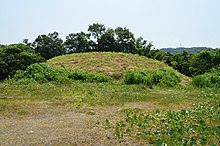| 中郷古墳群 | |
 Mukaideyama Kofun 1 Mukaideyama Kofun 1 | |
  | |
| Location | Tsuruga, Fukui, Japan |
|---|---|
| Region | Hokuriku region |
| Coordinates | 35°38′08″N 136°05′09″E / 35.63556°N 136.08583°E / 35.63556; 136.08583 |
| Type | kofun cluster |
| History | |
| Founded | 4th-5th century AD |
| Periods | Kofun period |
| Site notes | |
| Public access | Yes (no public facilities) |
| National Special Historic Site of Japan | |
The Nakagō Kofun Cluster (中郷古墳群, Nakagō Kofun-gun) is a group of kofun burial mounds located in the Sakashita neighborhood of the city of Tsuruga, Fukui in the Hokuriku region of Japan. The site was designated a National Historic Site of Japan in 1988.
Overview
Nakagō Kofun Cluster is located on a hillside east of the centre of the city of Tsuruga facing the Sea of Japan, and consists of two separate groups: the Mukaiyama Kofun Cluster (向出山古墳群, Mukaiyama Kofun-gun) and the Myōjinyama Kofun Cluster (明神山古墳群, Myōjinyama Kofun-gun). These tumuli date from the 4th to 6th century AD and were discovered during the construction of a highway bypass connecting the Hokuriku Expressway with Japan National Route 8, during which time a number of other archaeological discoveries were made, including the Yoshikawa Site, a Yayoi period settlement, and the Kotanigahora Kofun Cluster; however, neither of these sites received government protection and were totally destroyed during highway construction after a hasty compliance excavation. The Nakagō Kofun Cluster itself did not receive full protection, and within the site only Mukaiyama Tombs 1, 3 and 4 and Myōjinyama Tombs 1, 2, 3, 9 and 10 are covered by the National Historic Site designation.
Mukaiyama Tomb 1 was excavated several times starting in 1954, and the two vertical-type burial chambers were opened. Grave goods found include weapons such as swords, spearheads, and fragments of gold-plated armor and helmets, bronze mirrors, and agricultural implements. The weapons in particular are considered to be rare examples nationwide, and have been preserved since 2010 at a private folk museum in Tsuruga.
The tumuli are about 15 minutes by car from Tsuruga Station on the JR West Hokuriku Main Line.
Mukaiyama site
This site consists of three surviving circular-type kofun [ja] (empun (円墳)) on a hilltop ridge in the Yoshikawa neighborhood of Tsuruga. There is an explanatory plaque in front of each tumulus.
- Mukaiyama No.1: A large burial mound from the end of the fifth century, diameter 60 meters, height nine meters in two stages, faced with fukiishi stones. There is also a possibility that it was originally a scallop-shaped tumulus with a total length of 75 meters. There are two pit-type stone chambers at the top of the mound, and a large number of burial items have been excavated. However, the south side is partly missing due to construction work.
- Mukaiyama No.2: This was a circular tumulus from the 5th century, possibility older than Mukaiyama No. 1. It was demolished during the construction work of 1983.
- Mukaiyama No.3: This is a circular tumulus from the second half of the sixth century, with a diameter of 15 meters, a height of four meters, with a corridor-type stone chamber (total length 7.2 meters, length of the entry room 3.7 meters, width of 2.0 meters, height 2.7 meters).
- Mukaiyama No.4: This is a circular tumulus from the second half of the sixth century, diameter eight meters, height two meters, partially collapsed due to overgrowth of trees and plants.
Myōjinyama site
This site consisted of 23 kofun, of which five survive, on a hilltop ridge in the Sakanoshita neighborhood of Tsuruga. The site does not have any pathways or placards.
- Myōjinyama No.1: Keyhole-shaped tumulus (zenpō-kōen-fun (前方後円墳)) from the 4th century, length 47 meters, height 5.5 meters, faced with fukiishi stones.
- Myōjinyama No.2: Circular tumulus [ja] from the 4th century
- Myōjinyama No.3: Keyhole-shaped tumulus from the 4th century, length 53.5 meters, height seven meters
- Myōjinyama No 9: A keyhole-shaped tumulus from the first half of the sixth century, a length of 20 meters, a height of three meters, with a lateral hole type stone chamber
- Myōjinyama No.10: A circular tumulus [ja]
See also
References
- "中郷古墳群" [Nakago kofun cluster] (in Japanese). Agency for Cultural Affairs. Retrieved August 20, 2020.
- ^ Isomura, Yukio; Sakai, Hideya (2012). (国指定史跡事典) National Historic Site Encyclopedia. 学生社. ISBN 4311750404.(in Japanese)
External links
- Tsuruga city home page (in Japanese)
- Cultural Heritage of Fukui Prefecture (in Japanese)